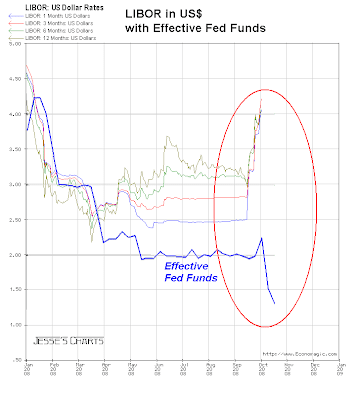 The new welfare queens, the Wall Street bankers, put all other non-military government programs to shame.
The new welfare queens, the Wall Street bankers, put all other non-military government programs to shame.
All holders of US dollars are going to be paying for this.
Taxation without representation is ... crony capitalism and dollar hegemony.
Cost of U.S. Crisis Action Grows, Along With Debt
By Matthew Benjamin
Oct. 10 (Bloomberg) -- The global financial crisis is turning into a bigger drain on the U.S. federal budget than experts estimated two weeks ago, ballooning the deficit toward $2 trillion.
Bailouts of American International Group, Fannie Mae and Freddie Mac likely will be more expensive than expected. States are turning to Washington for fiscal help. The Federal Reserve said this week it will begin buying commercial paper, the short- term loans companies used to conduct day-to-day business, further increasing costs. And analysts now say the $700 billion bank- rescue plan passed by Congress last week may have to be significantly larger. (You are not really surprised at this are you? - Jesse)
``I always assumed they would be asking for more money along the way if it was necessary, and it looks like it's going to be necessary,'' said Stan Collender, a former analyst for the House and Senate budget committees, now at Qorvis Communications in Washington. ``At the moment, there's nothing happening here that's positive for the budget. Nothing.''
The 2009 budget deficit could be close to $2 trillion, or 12.5 percent of gross domestic product, more than twice the record of 6 percent set in 1983, according to David Greenlaw, Morgan Stanley's chief economist. Two weeks ago, budget analysts said the measures might push deficit to as much as $1.5 trillion.
Yields to Rise
That means a lot more borrowing by Treasury, which will push up interest rates, said Greenlaw. ``The Treasury's going to be ramping up supply dramatically over the course of coming months to meet this enormous federal budget obligation,'' Greenlaw told Bloomberg this week. ``The supply will trigger some elevation in yields.''
Treasuries have fallen the past four days even as stocks sank, a sign investors are preparing for bigger U.S. government borrowing. Benchmark 10-year note yields rose to 3.82 percent at 7:49 a.m. in New York, from a close of 3.45 percent Oct. 6.
Payments the government allocated to keep vital companies solvent are beginning to look insufficient.
AIG, the giant insurance company that was taken over by the government in mid-September, said this week it may access $37.8 billion from the Federal Reserve Bank of New York, in addition to the $85 billion the government already loaned it to stave off bankruptcy.
``You're in for a dime, you're in for a dollar on this one,'' said David Havens, a credit analyst at UBS AG. (And boy don't these jokers know it - Jesse)
The financial health and earnings prospects of Fannie Mae and Freddie Mac -- seized by the government on Sept. 7 to prevent them from failing -- worsened in the second and third quarters, the companies' government regulator said this week.
Price Declines
The companies and regulators are recalculating the value of all of their assets to factor in price erosion. That may mean the government will have to spend more to keep the firms solvent.
Earlier this week the Fed announced it will create a special fund to buy commercial paper, the credit that businesses use to finance payrolls and other ongoing expenses. The Treasury will deposit money into the Fed's New York district bank to help set up the new unit. A Fed official said Treasury funding for the program could be ``substantial.''
California, Alabama and Massachusetts are urging the Fed and Treasury to include their securities in rescue plans designed for banks and businesses. The $2.66 trillion U.S. market for state and city bonds has been all but frozen since Lehman Brothers Holdings Inc., weighed down by losses in mortgage-backed bonds, declared history's largest bankruptcy on Sept. 15.
California has said it needs to sell as much as $7 billion in notes to maintain its schools, health system and other public services. The Bush administration said it is reviewing the states' financial positions.
Plan for Banks
Meanwhile, Treasury Secretary Henry Paulson indicated two days ago that he is considering buying stakes in a wide range of banks in coming weeks to help recapitalize them.
Such a move is allowed under the $700 billion bailout package Congress passed last week. Edmund Phelps, winner of the 2006 Nobel Prize for economics and a professor at Columbia University, said such action is necessary -- and will likely turn out to increase the measure's cost. Spending beyond the amount set in last week's bill would require further Congressional approval.
``We have to recapitalize the banks,'' Phelps told Bloomberg Television this week. ``I don't imagine that there's enough money in the first Paulson plan to be able to do all that needs to be done in that direction.''
The additional borrowing could push the national debt well past 70 percent of GDP, the highest since the immediate aftermath of World War II, when the U.S. was still paying off war debt....








































